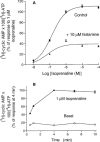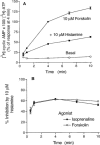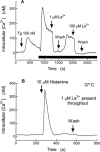Characteristics of the Ca(2+)-dependent inhibition of cyclic AMP accumulation by histamine and thapsigargin in human U373 MG astrocytoma cells
- PMID: 10882386
- PMCID: PMC1572168
- DOI: 10.1038/sj.bjp.0703411
Characteristics of the Ca(2+)-dependent inhibition of cyclic AMP accumulation by histamine and thapsigargin in human U373 MG astrocytoma cells
Abstract
1. Histamine, acting on H(1)-receptors, caused a Ca(2+)-dependent inhibition of forskolin- and isoprenaline-induced cyclic AMP accumulation in monolayers of human U373 MG cells (IC(50) 1.3+/-0.3 microM, maximum inhibition 66+/-3%). The inhibition was not reversed by the protein kinase inhibitor K-252A. 2. Thapsigargin also inhibited cyclic AMP accumulation (IC(50) 6.0+/-0.3 nM, maximum inhibition 72+/-1%). In the absence of extracellular Ca(2+) 5 microM thapsigargin caused only a 12+/-2% inhibition of cyclic AMP accumulation. 3. The inhibitory effect of 100 nM thapsigargin on forskolin-stimulated cyclic AMP accumulation was blocked by La(3+) (best-fit maximum inhibition 81+/-4%, IC(50) 125+/-8 nM). In contrast, the inhibitory action of 10 microM histamine was much less sensitive to reversal by 1 microM La(3+) (33+/-5% reversal, compared with 78+/-6% reversal of the inhibition by thapsigargin measured concurrently). However, in the presence of both thapsigargin and histamine the inhibition of cyclic AMP accumulation was reversed by 1 microM La(3+) to the same extent as the inhibition by thapsigargin alone. 4.++Thapsigargin (5 microM)+1 microM La(3+) caused only a 20+/-1% inhibition of histamine-stimulated phosphoinositide hydrolysis. 5. There was no indication from measurement of intracellular Ca(2+) of any persistent La(3+)-insensitive Ca(2+) entry component activated by histamine. 6. The results provide evidence that Ca(2+) entry is required for the inhibition by histamine and thapsigargin of drug-induced cyclic AMP accumulation in U373 MG astrocytoma cells. The differential sensitivity of the inhibitory action of the two agents to block by La(3+) suggests that more than one pathway of Ca(2+) entry is involved.
Figures










References
-
- ANTONI F.A. Calcium regulation of adenylyl cyclase: relevance for endocrine control. Trends Endocrinol. Metab. 1997;8:7–14. - PubMed
-
- BALLESTAS M.E., BENVENISTE E.N. Elevation of cyclic AMP levels in astrocytes antagonizes cytokine-induced adhesion molecule expression. J. Neurochem. 1997;69:1438–1448. - PubMed
-
- BIAN J., GHOSH T.K., WANG J.-C., GILL D.L. Identification of intracellular calcium pools: selective modification by thapsigargin. J. Biol. Chem. 1991;266:8801–8806. - PubMed
Publication types
MeSH terms
Substances
Grants and funding
LinkOut - more resources
Full Text Sources
Miscellaneous

